Mönchengladbach
Mönchengladbach (German pronunciation: [mœnçn̩ˈɡlatbax] (![]()
Mönchengladbach | |
|---|---|
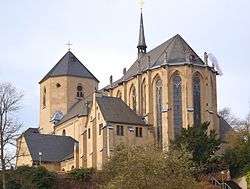 Mönchengladbach Minster | |
 Flag  Coat of arms | |
Location of Mönchengladbach in North Rhine-Westphalia 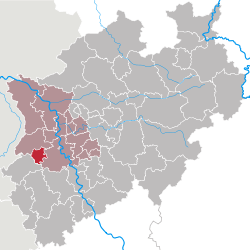 | |
 Mönchengladbach 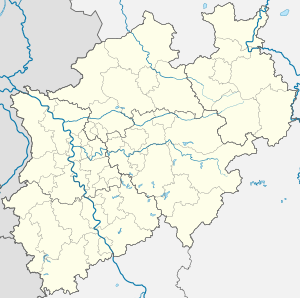 Mönchengladbach | |
| Coordinates: 51°12′0″N 06°26′0″E | |
| Country | Germany |
| State | North Rhine-Westphalia |
| Admin. region | Düsseldorf |
| District | Urban districts of Germany |
| Government | |
| • Lord Mayor | Hans Wilhelm Reiners (CDU) |
| Area | |
| • Total | 170.43 km2 (65.80 sq mi) |
| Elevation | 70 m (230 ft) |
| Population (2018-12-31)[1] | |
| • Total | 261,454 |
| • Density | 1,500/km2 (4,000/sq mi) |
| Time zone | CET/CEST (UTC+1/+2) |
| Postal codes | 41001–41239 |
| Dialling codes | 02161, 02166 |
| Vehicle registration | MG |
| Website | www.moenchengladbach.de |
Geography
Municipal subdivisions


Since 2009, the territory of Mönchengladbach has comprised four (previously ten) boroughs which are subdivided into 44 districts.[2]
The boroughs and their associated districts
- Nord: Am Wasserturm, Dahl, Eicken, Gladbach, Hardt-Mitte, Hardter Wald, Ohler, Venn, Waldhausen, Westend, Windberg
- Ost: Bettrath‑Hoven, Bungt, Flughafen, Giesenkirchen‑Mitte, Giesenkirchen‑Nord, Hardterbroich‑Pesch, Lürrip, Neuwerk‑Mitte, Schelsen, Uedding
- Süd: Bonnenbroich‑Geneicken, Geistenbeck, Grenzland‑Stadion, Heyden, Hockstein, Mülfort, Odenkirchen‑Mitte, Odenkirchen‑West, Pongs, Rheydt, Sasserath, Schloss Rheydt, Schmölderpark, Schrievers
- West: Hauptquartier, Hehn, Holt, Rheindahlen‑Land, Rheindahlen‑Mitte, Wanlo, Wickrath-Mitte, Wickrath‑West, Wickrathberg
History
Name and origins
The original name of the city was Gladbach, which is even today often applied to the town. To distinguish the town from another town of the same name (the present Bergisch Gladbach), it took the name München-Gladbach in 1888. Between 1933 and 1950 it was written München Gladbach (short: M. Gladbach), without hyphen. This spelling could mislead people to think that Gladbach was a borough of Munich (München in German), and consequently the name was changed to Mönchen-Gladbach in 1950 and Mönchengladbach in 1960.
The origin of the town was an abbey founded in 974. It was named after the Gladbach, a narrow brook, that mostly runs underground today. The abbey and adjoining villages became a town in the 14th century. The town of Rheydt is located nearby and is incorporated into Mönchengladbach today.
The second part of the name, Gladbach (cognate with English Ladbrooke) originates from Low German (Limburgisch[3]) and means canalised stream, referring to the small river (the Strunde) that was artificially canalised (laid) in early medieval times. In Limburgisch[3], the regional dialect, laid is said gelaat, a word which eventually evolved to glad (in this case the 'd' is pronounced as a 't'). The second part of the word, bach is the standard German word for a small stream.
Early history
The first settlements in the area of Mönchengladbach are approximately 300,000–400,000 years old and show remains of Homo erectus and Neanderthal. There are numerous cairns from the Neolithic and the Bronze Age.
The history of Mönchengladbach began with the construction of the Gladbach Minster and the founding of an abbey in the year 974 by Gero, Archbishop of Cologne, and his companion, the monk Sandrad of Trier.
To advance the settlement, the monks created a market north of the church in the 12th century. Craftsmen settled near the market. Gladbach received its town charter in 1364–1366. The "town" got a town wall made of stone, which had to be maintained by the citizens. Remains of that wall can be found at the Geroweiher, as can remains of the "Thick Tower", an old fortified tower at the Waldhausener hill. Until the end of the 18th century the city belonged to the department of Grevenbroich within the duchy of Jülich.
On 4 October 1794, the armed forces of the French revolution marched into the town, one day before the fortress Jülich had been handed over. When the Holy Roman Emperor Francis II ceded the left bank of the river Rhine to France with the Treaty of Lunéville in 1801, Gladbach fell under French laws suppressing religion. This was the end for the abbey, and the monastery was closed. On 31 October 1802, the last 31 monks left the monastery. The contents of the tremendous abbey library, well known outside Germany, were scattered or destroyed.
From 1798 until 1814, the Mairie Gladbach was part of Canton Odenkirchen, of the Arrondissement Krefeld, of the Roer Département.
Recent history
In 1815, Gladbach became part of the Kingdom of Prussia and seat of the Landkreis Gladbach, which was dissolved in 1929. In 1815 Gladbach became seat of the Bürgermeisterei (Office of mayor), which was split in 1859 into two parts: the City of Gladbach and Office of Mayor Obergeburth. The latter was renamed to München-Gladbach-Land in 1907.
From 1933 through 1975, the neighborhood of Rheydt was an independent city; the split from München-Gladbach was arranged by Joseph Goebbels, who was born locally. After reuniting with Mönchengladbach, the central station (Rheydt Hauptbahnhof) kept its original name, making Mönchengladbach the only city in Germany to have two rail stations each called Hauptbahnhof.
In response to the 10 May 1940 German invasion of Belgium, Mönchengladbach was bombed by British Bomber Command on the evening of 11 May. The bomber crews were attempting to interdict German troop movements on roads, intersections and rail lines in the area, especially the city's railyards. About half of the approximately 36 twin-engine RAF bombers reportedly hit their targets, and three were shot down.[4][5][6] Four people were killed on the ground, including a British woman living in Germany.[7]
After the Second World War, in compensation of the occupation of the Netherlands by Germany, several German cities were proposed to be ceded to the Kingdom of the Netherlands. Though never approved, the project would have renamed Mönchengladbach to Monniken-Glabbeek.
Eventually, the Prussian Rhine Province was dissolved after World War II, and the city became part of the new state of North Rhine-Westphalia which was formed in 1946.
| Largest groups of foreign residents | |
| Nationality | Population (31.12 2019) |
|---|---|
| 6,614 | |
| 3,938 | |
| 3,937 | |
| 2,966 | |
| 2,872 | |
| 1,926 | |
| 1,860 | |
| 1,651 | |
| 1,410 | |
| 1,176 | |
Economy
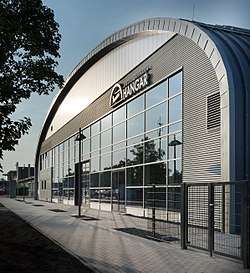
Mönchengladbach's industrial ascent was mainly influenced by the development of the textile industry from the mid-19th to the mid-20th century. In addition, a textile-oriented machine industry also developed.
After the Second World War, a major structural change began, reducing the importance of the textile industry and attracting new economic sectors. At present, only 7 percent of employees work in the once dominant textile and clothing industry (for example: Van Laack and gardeur).
As part of the successful diversification of the business location, local government and representatives founded the Mönchengladbach Business Development Corporation (WFMG) in 1997. WFMG and the University of Applied Sciences Niederrhein have developed a five-pillar model for the future orientation of the business location. Thereafter textile and fashion, mechanical engineering and electrical engineering, logistics, the creative industry and the health sector are the leading sectors for the economic future of the city of Mönchengladbach. As part of an active cluster policy, the WFMG has partly initiated its own networks for these industries.[8]
The most important employer in Mönchengladbach is the Santander Consumer Bank, which has its headquarters at Aachener Straße in Mönchengladbach's city center.
The economic structure includes: tool and spinning machines (Dörries Scharmann, Monforts, Trützschler, Schlafhorst), automatic conveyor systems, signal and system technology (Scheidt & Bachmann), transformers (SMS Meer), cables (Nexans Germany formerly Kabelwerk Rheydt), printed matter and foodstuffs.
Chocolatier Heinemann is known beyond the city limits for his cakes, pralines and baked goods, which he offers in cafés on site as well as in Düsseldorf and Munich. Furthermore, beer breweries are represented in Mönchengladbach. The Oettinger brewery produces at the site of the former Hannen brewery. The Hensen brewery has been producing a lower Rhine-type Altbier since 2015 at the former spring of the river Gladbach in the Waldhausen district.
Especially in the 1970s and 1980s nightlife was attractive to young party people from Düsseldorf. In the meantime, tourism in particular is playing a certain role. Mönchengladbach has about 40 hotels (for example: Hotel Burgund) and inns as well as a youth hostel in the district Hardter Wald. In total there are about 2000 beds. The number of overnight stays is over 200,000 annually.
Mönchengladbach Airport is dominated by general aviation. There are currently no scheduled services to and from Mönchengladbach. Additionally, there are few business-charter passenger flights. In June 2015 Hugo Junkers Hangar was opened as an aviation and event facility. Airplane enthusiasts can book sightseeing flights with Junkers Ju 52 from the 1940s.[9][10] The next major international airport Düsseldorf Airport is only 20 kilometres (12 mi) away to the east.
Points of interest
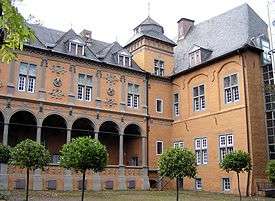
- Municipal Abteiberg Museum for contemporary art
- Municipal Museum Schloss Rheydt for fine art
- Museum im Wasserturm Rheindahlen for relics of the Stone Age
- Museum Altes Zeughaus e. V. for Carnival
- Museum Schloss Wickrath for ornithology
- Bunter Garten, municipal park with botanical garden and arboretum
- Wasserturm Mönchengladbach
Twin cities
Notable people
Gallery of people with a reference to Mönchengladbach:
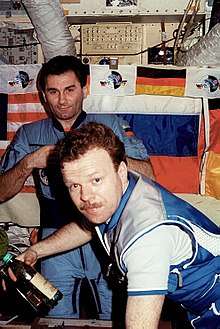 Reinhold Ewald,
Reinhold Ewald,
physicist and ESA astronaut Nick Heidfeld,
Nick Heidfeld,
Formula One driver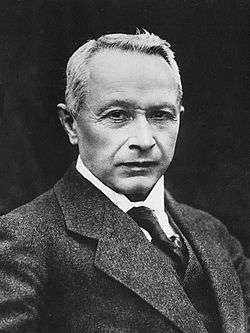 Hugo Junkers,
Hugo Junkers,
aircraft designer- Heinz Mack,
painter 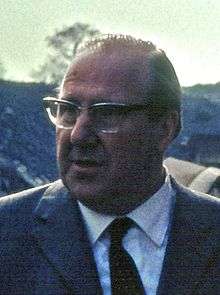 Franz Meyers,
Franz Meyers,
prime minister North Rhine-Westphalia Charlotte Roche,
Charlotte Roche,
actress and author
These people were born in Mönchengladbach, or in Rheydt or Wickrath, formerly independent communities united with Mönchengladbach in 1975.
- 1834, 12 November, Franz Brandts † 5. October 1914, entrepreneur, founder of the Volksvereins für das katholische Deutschland
- 1859, 3 February in Rheydt, Hugo Junkers, † 3 February 1935 in Gauting, engineer and entrepreneur, designer of airplanes
- 1883, 9 December, Joseph Hubertus Pilates, proponent of the Pilates Method.
- 1897, 29 October in Rheydt, Joseph Goebbels, † 1 May 1945 in Berlin, Minister of Propaganda and popular information in Nazi Germany
- 1898, Lisel Haas, died 1989, photographer[11]
- 1903, 10 May, Hans Jonas, died 5 February 1993, German philosopher and scholar, wrote extensively on ethics among other topics
- 1908, 31 July, Franz Meyers, died 27 January 2002, German politician (CDU), former prime minister North Rhine-Westphalia
- 1918, circa, Hans Mannheimer chemist, inventor of no tear baby shampoo and cosmetic chemicals, founder of the Mannheimer Foundation and The Miranol Chemical Company
- 1923, 25 December, Jack Zunz, died 11 December 2018, civil and structural engineer, former chairman of Ove Arup & Partners, principal structural designer of the Sydney Opera House
- 1933, 15 September, Petra Schürmann, died 14 January 2010, Miss Germany 1956, Miss World 1956
- 1943, 16 March, Hans Heyer, Racing driver known for starting in the 1977 German Grand Prix despite failing to qualify
- 1944, 14 September, Günter Netzer, German football player for Borussia Mönchengladbach, Real Madrid and Grasshoppers Zürich
- 1950, 27 April, Bernhard Schink, Präsident der Federation of European Microbiological Societies (FEMS) 2010–2013, Prorektor für Forschung, Universität Konstanz 2004-2007
- 1951, 20 March, Peter Klusen, German writer, translator and cartoonist
- 1957, 25 March, Ulrike von der Groeben, née Elfes, television personality
- 1957, 24 May, Walter Moers, author
- 1967, 18 May, Heinz-Harald Frentzen, Formula One driver
- 1971, 29 January, Jorg Albertz, German football player for Fortuna Düsseldorf, Hamburger SV, Rangers, Shanghai Shenhua, Greuther Furth and Clyde
- 1977, 10 May, Nick Heidfeld, Formula One driver
- 1979, 13 January, Joscho Stephan, Gypsy Jazz guitarist
- 1979, Joko Winterscheidt, German television presenter
- 1985, 4 November, Marcell Jansen, German football player for Hamburger SV who formerly played for Borussia Mönchengladbach
- 1988, 23 June, Isabell Herlovsen, Norwegian international footballer
- 1992, 30 April, Marc-André ter Stegen, German football goalkeeper for F.C. Barcelona who previously played for Borussia Mönchengladbach
Transport
The city has two main railway stations: Mönchengladbach Hauptbahnhof and Rheydt Hauptbahnhof, the result of the merger of the two cities, in which the deprecated name for Rheydt Hbf was never removed. Line 8 of the Rhine-Ruhr S-Bahn connects the city to Düsseldorf and Hagen; an extension further westwards is being discussed. A number of regional trains serve Mönchengladbach. By the end of 2009 it was the largest city in Germany without regular long-distance services. With the new schedule for 2010, Mönchengladbach got an InterCity/Intercity-Express connection twice a week.[12]
The city also has a commercial airport called Düsseldorf Mönchengladbach.
Local bus and rail transport is carried out by the NEW-AG under the VRR transport association regulations.
Sports
Football
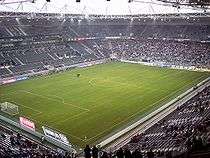
Mönchengladbach has a long football tradition. Its home club, Borussia Mönchengladbach, is one of the country's most well-known, best-supported, and successful teams. The team has the fourth largest fan club in Germany, "The Foals" (Die Fohlen), with more than 50,000 active members.
Gladbach is famous for their attacking style. The club was one of the strongest European football teams in the 1970s, winning the top tier Bundesliga five times. The club lost the 1977 final of the European Cup to Liverpool, but also made four appearances in the UEFA Cup final, with wins in 1975 and 1979, while losing in 1973 and 1980. However, after a last place finish in the top tier league during the 2006–07 season, they were relegated to the second tier for the 2007–08 season. They returned to the top tier in 2008, surviving relegation in the 2010–11 season, and finishing fourth in the 2011–12 season.
Football stadium
On 30 July 2004, the opening of the new stadium, "Borussia-Park", was celebrated. It has a capacity of 54,700 (seated: 34,300, standing: 20,400) which is reduced to 45,600 during International games. The stadium can be reached by car (via a dedicated Autobahn exit), by bus, and by train.
| Club | League | Sport | Venue | Established | Rebuilt | Capacity |
|---|---|---|---|---|---|---|
| Borussia Mönchengladbach | Bundesliga | Football | Borussia-Park | 1900 | 2004 | 54,000 |
Field hockey
The city hosted three International Field Hockey world championships: the 2006 Men's World Hockey Cup, the 2008 Women's Hockey Champions Trophy, and the 2010 Men's Hockey Champions Trophy.
Harness racing
Since 1892, Mönchengladbach has owned a harness racing track called Trabrennbahn Mönchengladbach (Trotting track Mönchengladbach).
Military
Until December 2013, the Rheindahlen Military Complex was located just outside Mönchengladbach, where it was home to the headquarters of the British Armed Forces in Germany.
References
- "Bevölkerung der Gemeinden Nordrhein-Westfalens am 31. Dezember 2018" (in German). Landesbetrieb Information und Technik NRW. Retrieved 10 July 2019.
- Dieter Weber (23 January 2009). "Vier Bezirke bei der Kommunalwahl". RP ONLINE GmbH. Archived from the original on 18 May 2011. Retrieved 10 March 2010.
- de:Niederrheinisch
- Grayling, A. C. (2011). Among the Dead Cities: Is the Targeting of Civilians in War Ever Justified?. A&C Black. p. 27. ISBN 9781408827901.
- Spingola, Deanna (2014). The Ruling Elite. Trafford Publishing. pp. 541–2. ISBN 9781490734743.
- Diefendorf, Jeffry M. (1993). In the Wake of War : The Reconstruction of German Cities after World War II: The Reconstruction of German Cities after World War II. Oxford University Press. p. 5. ISBN 9780195361094.
- Bowman, Martin (2011). Bomber Command: Reflections of War. Casemate. pp. 41–2. ISBN 9781848844926.
- "Archived copy". Archived from the original on 5 July 2018. Retrieved 4 July 2018.CS1 maint: archived copy as title (link)
- "Ju 52 Rundflüge – Ein tolles Erlebnis für groß und klein – Eine weitere WordPress-Website". Ju 52rundflug.de. 13 June 2018. Retrieved 21 September 2018.
- "Archived copy". Archived from the original on 23 August 2018. Retrieved 4 July 2018.CS1 maint: archived copy as title (link)
- "Bio". The Moseley Society Local History Group. 2012.
- Mönchengladbach: ICE-Anbindung nach Berlin (accessed Nov. 2009)
External links
| Wikivoyage has a travel guide for Mönchengladbach. |

